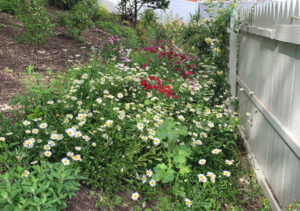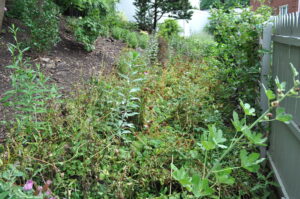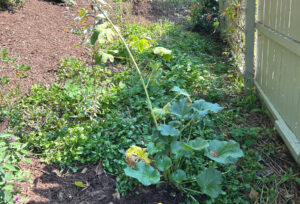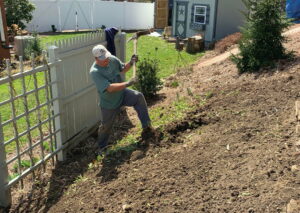The Mini-Meadow Flourishes… Then Flops
October 8th, 2024
For a while there in late spring, my backyard mini-meadow looked like it was hitting the reputed third-year charm.

The mini-meadow the third week of May 2024.
About half of this six-by-20-foot experimental plot on my sunny back bank was in color for about three weeks in late May to mid-June.
It was splendid and by far the best performance since I seeded the bed in May 2022 with a mix of mostly native species from the American Meadows seed company.
Then the Shasta daisies and sweet williams that were looking so good finished blooming. The blossoms and flower stalks browned and flopped over.
Worse yet, nothing was filling in to pick up the slack from the fallen neighbors.
With the goutweed and assorted other weeds underneath that had elbowed into the planting, it turned into a mess by early July. It stayed pretty forlorn the rest of the summer, too.
If this garden had been out front, I probably would have got a cut-the-weeds notice from the local code enforcement officer.
After the three weeks of spring glory, that was it for the 2024 show.

The mini-meadow the third week of June 2024.
The cosmos that gave a fair performance in the second half of 2023 was a total no-show this year. Even though I left last year’s cosmos plants alone to reseed themselves, not a one sprouted.
Neither did the melampodium that I planted into the bed last summer. Those reseed themselves in my front-yard and mailbox beds, but none reappeared in the mini-meadow.
And I got no-shows from the sunflowers and butterfly milkweed seeds that I scattered this spring in an effort to beef up the original seeding.
Granted, it was a hot, dry summer, but watering and weeding to baby things along goes against the idea of a meadow in the first place – a bed that’s supposed to care for itself.
After three full growing seasons, I’m beginning to verify what a lot of gardeners told me from their own experiences – that most of the original seeded-in plants disappear to leave just one or two dominant species and that weeds eventually win the battle.
I planted my mini-meadow on a mostly sunny bank in my back yard mainly to get some first-hand experience on what’s become a trendy style.
I was looking for a low-care, low-cost way to cover a tough site that’s not easy to work, and I liked the idea of adding diversity to encourage pollinators and beneficial insects. That’s why I picked American Meadows’ seed mix of 27 mostly native species that are geared specifically to the Northeast.
I put in a lot of work preparing the bed – mainly digging out weeds and loosening the compacted clay.
Read more on how George planted the mini-meadow
In year one, I was rewarded with a few blooms of coreopsis, candytuft, calendula, cornflowers, nigella, cosmos, and red and orange poppies.
Despite my proactive anti-weed efforts, by year two the bed was about a 50-50 mix of weeds and wildflowers.
I did get some flashes of color here and there, although never more than about 10 or 15 percent of the planting at any one time.
Shasta daisies and cosmos were the two best year-two bloomers, along with a smattering of calendula, coreopsis, Siberian wallflower, red poppies, and sweet williams.
Two hollyhocks and a single lupine came up but didn’t flower in year two, and I noticed one sunflower that sprouted but snapped off before blooming.
I also got some year-two color from three red beebalms and a purple coneflower that I transplanted.
I thought I turned the corner in late May of this year when the bed was actually colorful and attractive for the aforementioned three weeks. But all the color was from just two species – Shasta daisies and sweet williams.

The mini-meadow the third week of July 2024.
Once those finished, my dreamed diversity wasn’t very diverse at all.
Other than a single lupine, a single hollyhock, and a meager attempt by the returning transplanted coneflower and one transplanted beebalm (the other two died), this was a colorless garden from late June on.
I never have seen a single appearance by about half of the species in the original mix, including larkspur, prairie coneflower, catchfly, rose mallow, scarlet flax, blue flax, gaillardia, baby blue eyes, and black-eyed susan.
Even most of the species that came up in year one or year two are now apparently history, i.e. coreopsis, candytuft, calendula, cornflowers, nigella, poppies, and Siberian wallflower.
What is thriving is a growing diversity of weeds.

The mini-meadow the third week of August 2024.
The worst of the bunch is goutweed, a carrot-family spreading clumper with toothed, green leaves that form in groups of three. It’s a weed that typically gets started from seeds thrown off by a variegated form of the plant – variegated bishop’s weed – that a lot of people used to plant as a groundcover.
Once the aggressive green-leafed form takes hold, it spreads by runners that are almost impossible to eradicate. Like thistle, if you don’t get every last little piece, the left-overs come back with new vengeance.
I inherited goutweed on my back bank and tried grubbing out every piece of it that I could find with a mattock and trowel before planting.
I also tried the weed “sucker punch” technique of letting the bed bare so any remaining weeds or weed seeds would come up before planting the meadow. I dispatched those before seeding.
Despite the double killing attempt, the goutweed is gaining a foothold. And this time it’s harder to control since it’s mixed in with the meadow plants.

George de-weeding and loosening soil in preparation for seeding the mini-meadow.
This year I’m also now getting thistle, nightshade, ragweed, oxalis, and hawkweed.
I’ve tried selective weed-digging, but again, that’s the kind of work I was hoping to avoid by going with a meadow. If I’m going to have weed, water, reseed, and such, I might as well plant a “regular” garden.
So that’s where I’m at after three years of mini-meadowing. I’m going to see how things go next year. But if the flowers keep going downhill and the weeds keep gaining, I’ll be getting the mattock and shovel back out.







